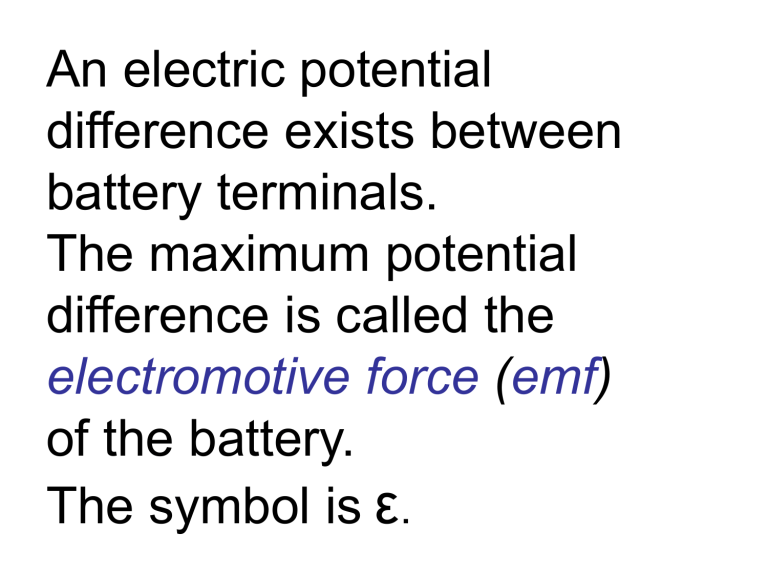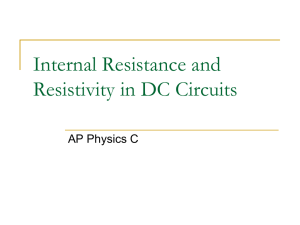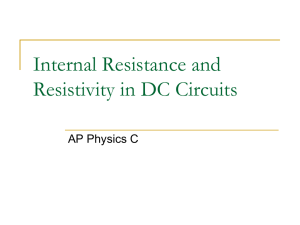An electric potential difference exists between

An electric potential difference exists between battery terminals.
The maximum potential difference is called the electromotive force ( emf ) of the battery.
The symbol is
ε
.
The battery creates an electric field within and parallel to a conducting wire.
This field exerts a force on the electrons within the wire causing them to move. This flow of charge is called electric current .
Current is the amount of charge per unit time that crosses an imaginary perpendicular surface.
I = ∆q/∆t
A rate of flow of one coulomb per second is one ampere (A) .
If charges move the same direction at all times it is called direct current (dc) .
If the charges change direction from moment to moment it is called alternating current (ac) .
Ex. 1 The current from the
3.0-V battery of a pocket calculator is 0.17 m
A. In one hour of operation, (a) how much charge flows in the circuit and (b) how much energy does the battery deliver to the calculator circuit?
We use the concept of conventional current , which is the hypothetical flow of positive charges that would have the same effect as the flow of negative charges that actually does occur.
Greater battery voltages produce larger electric currents. Resistance is the ratio of the voltage V applied across a piece of material to the current I through the material,
R = V/I.
This relation R = V/I is called Ohm’s law .
(Also written as V = IR.)
The unit of resistance is the volt/ampere (V/A).
One volt/ampere is equal to one ohm ( Ω ).
A device that offers resistance to a circuit is called a resistor . In drawing electric circuits, a zigzag line represents a resistor and a straight line represents an ideal conducting wire.
Ex. 2 The filament in a light bulb is a resistor. The wire becomes hot enough to emit light because of the current in it.
A flashlight uses two 1.5-V batteries to provide a current of
0.40 A in the filament.
Determine the resistance of the glowing filament.
The resistance of a piece of material of length L and cross-sectional area A is:
R = ρL/A .
ρ is the resistivity of the material. The unit is the ohm•meter (Ω•m).
Metals have small resistivity, insulators have large resistivities.
Semiconductors have intermediate resistivity values.
Ex. 3 A lawn mower needs a 20gauge extension cord for distances up to 35 m, but a 16-gauge cord for longer distances, to keep the resistance small. The cross-sectional area of 20-gauge wire is 5.2 x 10 -7 m 2 , 16-gauge wire is 13 x 10 -7 m 2 .
Find the resistance of (a) 35 m of
20-gauge copper wire and (b) 75 m of 16-gauge copper wire.
Resistivity depends on temperature.
In metals, resistivity increases with increased temperature, vice-versa in semiconductors.
ρ = ρ
0
[1 + a
(T - T
0
)] a is the temperature coefficient of resistivity. When resistivity increases with increasing temperature, a is positive
(metals). When resistivity increases with decreasing temperature, a is negative
(semiconductors).
The temperature dependence of resistance is given by:
R = R
0
[1 + a
(T - T
0
)]
Ex. 4 A stove heating element contains a wire (L = 1.1 m,
A = 3.1 x 10 -6 m 2 ). The wire material has a resistivity of
ρ
0
= 6.9 x 10 -5 Ω•m at T
0
= 320ºC and a temperature coefficient of resistivity of a
= 2.0 x 10 -3 (Cº) -1 .
Determine the resistance of the heater wire at an operating temperature of 420ºC.
Superconductors have resistivity that decreases to zero below the critical temperature T
C
.
A current established in a superconducting ring continues forever without the need of an emf.
The energy of an amount of charge leaving a battery is equal to ∆qV.
Power is energy per unit time, so P = ∆qV/∆t.
∆q/∆t is equal to current I, so P = IV. The unit is the watt (W).
Since I = V/R,
P = IV becomes
P = V 2 /R and
P = I 2 R.
Ex. 5 The current in a flashlight is 0.40 A, and the voltage is 3.0 V. Find (a) the power delivered to the bulb and (b) the energy dissipated in the bulb in 5.5 minutes of operation.
AC typically fluctuates sinusoidally is a function of time t:
V = V
0 sin2π f t .
V is average voltage
V
0 is maximum voltage f is frequency in hertz t is time
Current I also follows this fluctuation:
I = I
0 sin2π f t
Power (P=IV) also fluctuates with time
P = I
0
V
0 sin2π f t
The average power is one-half the peak power,
1/2 • I
0
V
0
. This is also equal to (I
0
/√2)•(V
0
/√2) =
I rms
V rms
. These are the root mean squares of current and voltage.
All ac voltages and currents listed on appliances and used in this text are root mean squares.
V rms
= I rms
R P avg
= I rms
V rms
P avg
= I 2 rms
R P avg
= V 2 rms
/R
Ex. 6 A stereo receiver applies a peak ac voltage of 34 V to a speaker. The speaker behaves approximately as an 8.0Ω resistance. Determine (a) the rms voltage, (b) the rms current, and (c) the average power for this circuit.
Series wiring means that the devices are connected in such a way that there is the same electric current through each device.
One loop only for the flow of electricity.
When resistors are connected in series, I is constant, the V is divided between the two resistors (V
1
+V
2
= V sum of the individual
T
), and the equivalent resistance R
S is the resistances (R
S
= R
1
+ R
2
, etc.).
Ex. 8 A 5.00Ω resistor and a 3.00-Ω resistor are connected in series with a
12.0-V battery. Assuming the battery contributes no resistance to the circuit, find (a) the current, (b) the power dissipated by each resistor, and
(c) the total power delivered to the resistors by the battery.
Parallel wiring means that the devices are connected in such a way that the same voltage is applied across each device. There is more than one pathway in which the current flows.
When two resistors are connected in parallel, each receives current as if the other were not present. This results in the equivalent resistance being less than either resistance R
1
1/R
P
= 1/R
1
+ 1/R
2 or R
2
.
, etc.
Ex. 9 Two speakers connected in parallel have an ac voltage of 8.00 V.
The main speaker resistance is 12.00 Ω, the remote speaker resistance is 6.00 Ω. Determine:
(a) the equivalent resistance of the two speakers, (b) the total current supplied by the receiver, (c) the current in each speaker,
(d) the power dissipated in each speaker,
(e) the total power delivered by the receiver.
Circuits are often wired partially in series and partially in parallel.
This can be a big mess, but we must learn it anyway.
(At least I’m honest.)
Find the total resistance in this circuit. What is the current through each resistor? What is the total power output of this circuit?
Ex. 11 – The following slide shows a circuit composed of a
24-V battery and four resistors, whose resistances are 110, 180,
220, and 250 Ω. Find
(a) the total current supplied by the battery and
(b) the voltage between points
A and B in the circuit.
Batteries and generators add resistance to a circuit.
This is called internal resistance . This can cause a drop in the emf value. The actual voltage of a battery is called terminal voltage .
Ex. 12 A car battery whose emf is 12.0 V has an internal resistance of
0.010 Ω. What is the terminal voltage when the current I drawn from the battery is (a) 10.0 A and (b) 100.0 A?
Kirchhoff’s Rules can be used to analyze circuits where individual groups cannot be combined.
The two rules are the junction rule and the loop rule.
The junction rule states that the total current directed into a junction must equal the total current directed out of the junction.
The loop rule states that for a closed circuit loop, the total of all the potential rises is the same as the total of all the potential drops.
Ex. 13 – The picture shows a circuit that contains two batteries and two resistors. Determine the current I in the circuit.
Ex. 14 A circuit operating a car’s headlights has an internal resistance of
0.0100 Ω for the 12.00-V car battery and its leads and a resistance of
1.20 Ω for the headlights. The alternator is approximated as an additional 14.00-V battery with an internal resistance of 0.100 Ω.
Determine the currents through the car battery (I
B
), the headlights (I
H
), and the alternator (I
A
).
Current is measured with an ammeter , which must be connected in series so all current passes through it. A good ammeter must have low resistance so as not to change the current.
A voltmeter measures the voltage between two points. It is not inserted into the circuit, but is connected in parallel. A good voltmeter must have a resistance large enough so that the device does not appreciably alter the voltage in the circuit.
When capacitors are connected in parallel the equivalent capacitance is the sum of the individual capacitances:
C
P
= C
1
+ C
2
, etc.
The energy stored in the parallel combination of capacitors is
1/2•C
P
V
2
.
Capactors connected in series, regardless of their capacitances, contain charges of the same magnitude, +q and -q, on their plates. For series capacitors:
1/C
S
= 1/C
1
+ 1/C
2
, etc.
An RC circuit contains a combination of resistors and capacitors. The capacitor discharges after a period of time during which charge is built up. the charging and discharging nature of a capacitor is used in pacemakers, intermittent wipers, etc.







